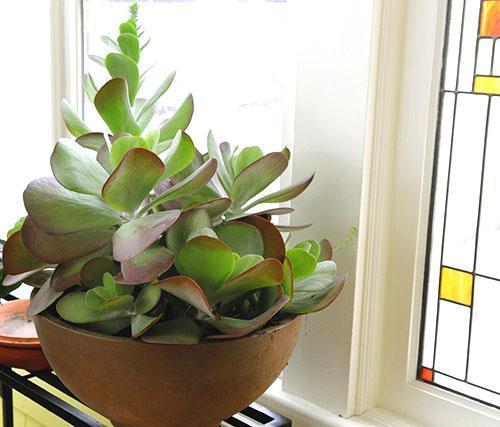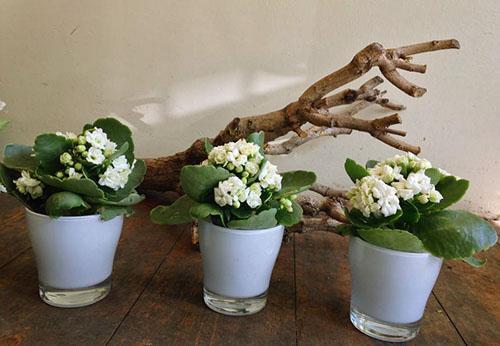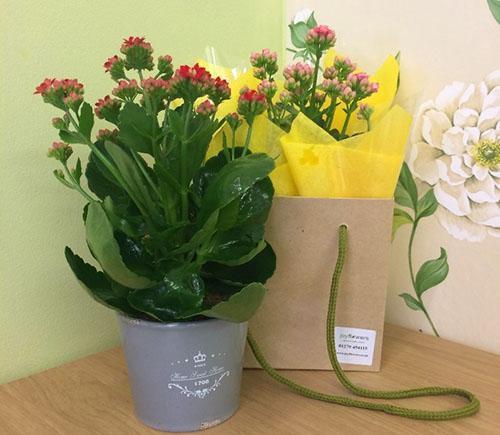How to transplant Kalanchoe on your own so that the plant will start and grow?
 At home, flower growers grow many species of such a diverse and at the same time unpretentious plant like Kalanchoe. On the windowsills today you can see the spectacular inflorescences of Blossfeld's Kalanchoe, the sharp leaves of the Kalanchoe Degremon, strewn with children, as well as gray, felt-covered, variegated and purple bushes outwardly dissimilar, but belonging to the same genus of immigrants from the subtropics and tropics of Africa, Australia and Asia. Lovers of indoor floriculture, Kalanchoe is attracted by its unusual appearance, and ease of care, numerous methods of reproduction and the ability to achieve flowering of this plant.
At home, flower growers grow many species of such a diverse and at the same time unpretentious plant like Kalanchoe. On the windowsills today you can see the spectacular inflorescences of Blossfeld's Kalanchoe, the sharp leaves of the Kalanchoe Degremon, strewn with children, as well as gray, felt-covered, variegated and purple bushes outwardly dissimilar, but belonging to the same genus of immigrants from the subtropics and tropics of Africa, Australia and Asia. Lovers of indoor floriculture, Kalanchoe is attracted by its unusual appearance, and ease of care, numerous methods of reproduction and the ability to achieve flowering of this plant.
If in nature different types of Kalanchoe in height can reach from 20 cm to 4 meters, then in a pot culture these perennial herbaceous dwarf shrubs do not exceed half a meter, grow well and regularly delight with the appearance of inflorescences.

Is Kalanchoe transplant necessary during flowering?
 Kalanchoe, with good care, grows rather quickly, while not only the aerial part, but also the root system grows. This means that from time to time the plants need to be transplanted into a larger pot or several Kalanchoe can be planted in separate containers. How to transplant Kalanchoe? And when is it better to carry out this procedure in order to less injure the plant and not interfere with its flowering?
Kalanchoe, with good care, grows rather quickly, while not only the aerial part, but also the root system grows. This means that from time to time the plants need to be transplanted into a larger pot or several Kalanchoe can be planted in separate containers. How to transplant Kalanchoe? And when is it better to carry out this procedure in order to less injure the plant and not interfere with its flowering?
Often, Kalanchoe of such decorative species as Kalandiva and Blossfelda come into the house already blooming. At the same time, flower growers face a difficult problem. Should you immediately transplant Kalanchoe, on which inflorescences of all shades flaunt?
If the bush is transplanted during the flowering period, this will become stress for the plant, to which it will respond by dropping the buds and long painful acclimatization.
It is better to postpone all manipulations with the bush until the moment when all flower stalks will fade and are cut off. Until that time, it is necessary to create acceptable temperature conditions for the Kalanchoe, to provide the indoor plant with proper watering and lighting... Before the producers plant the Kalanchoe in the soil, a certain amount of long-acting dressings must be added, which should be enough until the end of flowering.
 The only really serious problem at this time is the possible drying out of the soil in the small transport pot. It can be solved by placing the plant in a suitable size pots, and on the surface of the soil make a mulch layer of nutshells, sawdust, pebbles or other material. The first transplant of Kalanchoe at home is best done in the spring, when daylight hours begin to arrive, flowering ends, and the plant is ready to gain strength and grow.
The only really serious problem at this time is the possible drying out of the soil in the small transport pot. It can be solved by placing the plant in a suitable size pots, and on the surface of the soil make a mulch layer of nutshells, sawdust, pebbles or other material. The first transplant of Kalanchoe at home is best done in the spring, when daylight hours begin to arrive, flowering ends, and the plant is ready to gain strength and grow.
Kalanchoe transplant at home
 As in subsequent years, the first transplant is carried out with extreme caution.
As in subsequent years, the first transplant is carried out with extreme caution.
Before planting the Kalanchoe in a new container, pay attention to the condition of the root system and Kalanchoe stems.
Such an examination is necessary due to the sensitivity of the Kalanchoe roots to moisture stagnation and excessive watering.
- If dark spots of rot or mold are noticed on the roots, such areas are removed, and the places of trimming are treated with crushed coal.
- If the lesion has affected the stems, then below the damaged tissue, the shoot will have to be cut off in order to later use its healthy part as a cutting, and so plant the Kalanchoe.
 The plant is removed from the pot along with an earthen clod, trying not to lose the existing soil and not damage the roots. To facilitate the process, Kalanchoe is well watered shortly before transplanting. This is extremely useful if you have to plant the Kalanchoe, for example, removing from under a large bush small daughter plants, rooted layers or rosettes that have fallen from the leaves.
The plant is removed from the pot along with an earthen clod, trying not to lose the existing soil and not damage the roots. To facilitate the process, Kalanchoe is well watered shortly before transplanting. This is extremely useful if you have to plant the Kalanchoe, for example, removing from under a large bush small daughter plants, rooted layers or rosettes that have fallen from the leaves.
Then the lump is carefully placed on the drainage sprinkled with soil, fill the empty spaces around the plant with soil, compacting it a little. In the end, the surface of the soil is leveled and mulched with a layer of pebbles, crushed shells or large chips. This method of caring for Kalanchoe during transplantation at home will reduce moisture loss and prevent mold from developing, as well as prevent children and falling Kalanchoe leaves from contacting the ground and taking root.
 If this is not done, after a while it will be necessary to plant the Kalanchoe, since under an adult plant there will certainly be a mass of small rosettes that take nutrients and moisture from the bush.
If this is not done, after a while it will be necessary to plant the Kalanchoe, since under an adult plant there will certainly be a mass of small rosettes that take nutrients and moisture from the bush.
Choosing a pot for Kalanchoe
 A new bush pot is taken a couple of centimeters larger than the previous one. The optimal size of the slide for Kalanchoe is from 12 to 18 cm, depending on the variety and variety.
A new bush pot is taken a couple of centimeters larger than the previous one. The optimal size of the slide for Kalanchoe is from 12 to 18 cm, depending on the variety and variety.
 Flowering varieties do not like the neighborhood of other plants, even related species. But if an excessively wide pot is chosen for transplanting the Kalanchoe of such plants, this can lead to the growth of the green part of the bush and the rejection of flowering. You can get out of the situation by planting a couple of young rosettes, obtained from the apical petioles from the same bush or from children, to the Kalanchoe. Indoor flower beds of several plants, which at the same time give inflorescences of different shades, will look even more spectacular.
Flowering varieties do not like the neighborhood of other plants, even related species. But if an excessively wide pot is chosen for transplanting the Kalanchoe of such plants, this can lead to the growth of the green part of the bush and the rejection of flowering. You can get out of the situation by planting a couple of young rosettes, obtained from the apical petioles from the same bush or from children, to the Kalanchoe. Indoor flower beds of several plants, which at the same time give inflorescences of different shades, will look even more spectacular.
 Kalanchoe, naturally growing in arid deserts, for example, felt varieties or Kalanchoe Lucia, coexist well with other plants with a similar lifestyle. These types of Kalanchoe can be used to create indoor gardens that mimic the corners of the rocky desert of southern Africa or Madagascar, which will be a unique addition to the interior. The best material for the pot is unglazed ceramics, in which all the pores are preserved, which means that the plant breathes, and from the soil naturally excess moisture is removed.
Kalanchoe, naturally growing in arid deserts, for example, felt varieties or Kalanchoe Lucia, coexist well with other plants with a similar lifestyle. These types of Kalanchoe can be used to create indoor gardens that mimic the corners of the rocky desert of southern Africa or Madagascar, which will be a unique addition to the interior. The best material for the pot is unglazed ceramics, in which all the pores are preserved, which means that the plant breathes, and from the soil naturally excess moisture is removed.
Before the Kalanchoe is transplanted into the selected pot, the container is washed with hot water and treated with a solution of potassium permanganate.
Soil for Kalanchoe
 If the soil in the transport pot with Kalanchoe is mainly a mixture of peat and coconut fiber, then in a permanent place the plant will be more comfortable in the nutritious loose soil of a more harmonious composition, which must be maintained during subsequent transplantations of the bush. This technique allows you to minimize the adaptation of the Kalanchoe to new conditions.
If the soil in the transport pot with Kalanchoe is mainly a mixture of peat and coconut fiber, then in a permanent place the plant will be more comfortable in the nutritious loose soil of a more harmonious composition, which must be maintained during subsequent transplantations of the bush. This technique allows you to minimize the adaptation of the Kalanchoe to new conditions.
For Kalanchoe, soil with an acidity level of 5.0 to 6.5 is preferred. You can achieve this indicator by adding dolomite or lime flour to the soil.
The soil suitable for the Kalanchoe must pass oxygen and water well, provide proper nutrition and not contain components that are toxic or dangerous for the plant:
- As a soil, you can take it as a ready-made soil mixture for flower plants, diluting it by a quarter with clean sand.
- For those accustomed to the harsh conditions of the Kalanchoe deserts, it is possible to use soil for succulents.
 But it is better to prepare the soil for the Kalanchoe yourself, mixing in equal proportions high-quality humus, garden soil and coarse sand.
But it is better to prepare the soil for the Kalanchoe yourself, mixing in equal proportions high-quality humus, garden soil and coarse sand.
To give structure to the soil, add one part of a mixture of brick or expanded clay chips and crushed coal.
Since there are a lot of plant varieties, but all of them are rather unpretentious to the proposed soils, a mixture of the following can be used as soil for Kalanchoe:
- 4 parts peeled peat;
- 2 parts of sod land;
- 1 part river sand.
 To protect the plant from dangerous pathogens of fungal infections and pests of Kalanchoe remaining in humus and earth, the soil must be steamed or warmed up in an oven before planting. Don't forget about drainage. This is an indispensable part of arranging a Kalanchoe pot. The drainage layer, at least 2 cm thick, is made of fine expanded clay or crushed brick.
To protect the plant from dangerous pathogens of fungal infections and pests of Kalanchoe remaining in humus and earth, the soil must be steamed or warmed up in an oven before planting. Don't forget about drainage. This is an indispensable part of arranging a Kalanchoe pot. The drainage layer, at least 2 cm thick, is made of fine expanded clay or crushed brick.
After transplantation, the Kalanchoe undergoes acclimatization, during which the plant requires support. So special Kalanchoe care after transplantation at home, feeding becomes, which is carried out twice a month until the beginning of autumn.
How to plant Kalanchoe outdoors?
 In the middle lane and in warmer regions of the country, from the second half of April or in May, the Kalanchoe can be taken out onto the veranda, loggia or balcony.
In the middle lane and in warmer regions of the country, from the second half of April or in May, the Kalanchoe can be taken out onto the veranda, loggia or balcony.
Outdoor care is no different from what the plant receives in the room. And it is necessary to transplant Kalanchoe into home conditions after pruning, in mid-August, when the nights become cold.